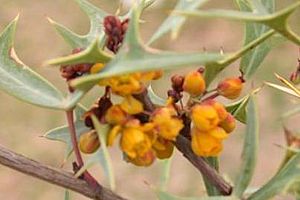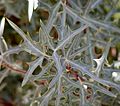Agarita facts for kids
Quick facts for kids Agarita |
|
|---|---|
 |
|
| Scientific classification | |
| Genus: |
Mahonia
|
| Species: |
trifoliolata
|
| Synonyms | |
|
|
Mahonia trifoliolata is a type of flowering plant often called agarita, agrito, or algerita. It belongs to the barberry family and grows in the southwestern parts of North America. The name "agarita" comes from a Spanish word meaning "to grab a little." This name probably describes the plant because it can be a bit prickly, but its spines aren't very big.
This plant usually has gray-green or blue-gray leaves, bright yellow flowers that bloom from February to April, and small red berries that appear in May. The berries are the most important part of the plant that people use, but its roots and seeds can also be helpful.
Contents
Where Agarita Grows
This shrub is native to Arizona, New Mexico, and Texas in the Southwestern United States. It also grows in northeastern Mexico, reaching as far south as Durango and San Luis Potosí. Agarita mainly grows in these areas and is not usually grown in other countries or states.
In Texas, you can find agarita on rocky slopes, cliffs, and in open woods. It's one of the most common bushes in the Hill Country region. It can cover large areas, sometimes seen as a plant that spreads very quickly. Even though people have tried to control its spread, it recovers fast and is tough to get rid of.
Throughout history, almost every part of the agarita plant has been used. Native Americans, like those from the Plains, used similar plants for food, medicine, and even to make dyes.
What Agarita Looks Like
Mahonia trifoliolata is an evergreen shrub, which means it keeps its leaves all year round. It can grow up to 3 to 8 feet (1 to 2.4 meters) tall and wide. It has stiff, spreading branches that often form dense groups of plants. Its leaves are usually gray-green to blue-gray, and each leaflet has sharp points at its ends.
Related Plants
Some experts believe that all plants in the Mahonia group should actually be part of the Berberis group. If that were the case, Mahonia trifoliolata would be called Berberis trifoliolata.
In Texas, there are a few less common types of agarita. These include the Texas barberry (Mahonia swaseyi), the red barberry (Mahonia haematocarpa), and the creeping barberry (Mahonia repens). The Texas barberry is quite rare. The red barberry grows in the southwestern U.S. in woodlands and grasslands. The creeping barberry is found in the Rocky Mountains at high elevations. All these related plants have berries you can eat. The creeping barberry has dark blue berries, while the Texas and red barberries have bright red ones.
How Agarita is Used
Agarita is very good at handling hot weather and dry conditions. In places where it grows naturally, many wild animals like it. Birds enjoy eating the fruits, and small mammals use the plant for shelter. The shrub is also a great source of nectar for honey bees and other insects. Because its leaves are tough and spiny, animals like cattle or deer usually don't eat them.
The bright red berries of the agarita are ready to pick around late April to early May. These fruits have a slightly sweet and sour juice. This juice can be used to make agarita wine or a fruit juice drink. The berries are also great for making jelly, pies, or cobblers. When mixed with sugar, their tart flavor is very pleasant. The fruits contain seeds, which can be used to grow new agarita plants or roasted to make a coffee-like drink. However, eating the raw berries can be tricky because of all the seeds.
Native American tribes, such as the Apache, Chiricahua, and Mescalero, used the fresh and dried fruit for food. They also used wood shavings from the plant as a traditional eye medicine and to make a yellow dye for animal hides. Early settlers also used a substance called berberine from the agarita roots to create a yellow dye.
Agarita also has medicinal uses. The berberine in its roots gives it healing properties. Historically, it was used to treat various problems, from fevers and stomach issues to open wounds. It was also used as a laxative by the Ramah Navajo and other groups. The roots are known to have antiseptic qualities, meaning they can help fight germs. This makes them useful for treating wounds, skin problems, or gum issues.
Growing Agarita
Mahonia trifoliolata is grown as an ornamental plant in gardens, especially in desert areas. It can handle drought and heat very well, meaning it can grow in dry periods without needing extra water. It usually grows best in full sun but can also do well in light shade. This plant doesn't like very cold weather, so it's mostly grown in places with short, mild winters.
You can grow new agarita plants from its seeds. The seeds need to be kept cold for 2 to 3 months before planting. So, you can plant them in summer or autumn, and they will sprout in the spring. Since it's a perennial plant, it lives for many years and doesn't need to be planted every year.
Agarita can grow in many different types of soil, including loam, clay, clay-loam, and gravel. It prefers dry, well-drained soils. It often grows in soils that come from limestone, so it can handle alkaline soil well.
Agarita doesn't have many known insect or disease problems. Sometimes, you might see leaf spots or rusts, especially black stem rust. Stem rust is a serious disease for crops like wheat, barley, oats, and rye. Since Mahonia trifoliolata can act as an intermediate host for this fungus, farmers sometimes remove agarita bushes to protect their crops. However, in the regions where agarita grows today, the climate is too dry for these cereal crops, so there's no need to remove the bushes.
Because the roots of agarita contain a lot of berberine, they can stop some root fungi from growing. This makes the plant quite resistant to many diseases.
Agarita in Nature
Agarita is often used by birds as a place to build nests or to hide from predators. It can also protect young seedlings of other trees and shrubs, keeping them safe from grazing animals. Birds eat the berries, while bees and butterflies feed on the nectar from its flowers. Since agarita blooms quite early in the year, it's one of the few sources of nectar available for insects in early spring.
Gallery





